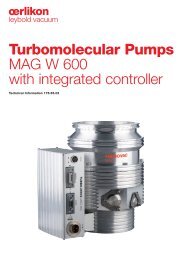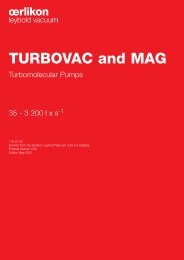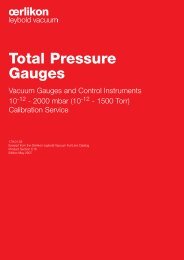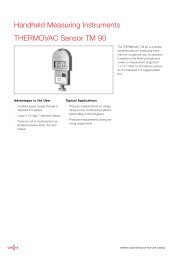You also want an ePaper? Increase the reach of your titles
YUMPU automatically turns print PDFs into web optimized ePapers that Google loves.
General Accessories<br />
Synthetic Oils<br />
Synthetic oils are man-made. The<br />
group of synthetic oils includes liquids<br />
differing widely as to their chemical<br />
structure and composition.<br />
Correspondingly their physical and<br />
chemical properties differ considerably.<br />
Synthetic oils are used in those cases<br />
where special properties of the oil are<br />
required which can not be fulfiled by<br />
mineral oils.<br />
The oils given in the following belong<br />
to the group of synthetic oils:<br />
Polyalphaolefin (PAO) Oils<br />
Polyalphaolefin oils are synthetic hydrocarbons<br />
which are paraffin like, but<br />
have a uniform structure. Thermal and<br />
chemical resistance is better compared<br />
to mineral oils. Elastomer compatibility<br />
and resistance against hydrolysis are<br />
comparable to mineral oils.<br />
Ester oils<br />
Ester oils are organic compounds<br />
which excel especially through their<br />
high thermal resistance to cracking<br />
compared to mineral oils. Chemical<br />
resistance is generally quite good, but<br />
will depend on the type of ester oil.<br />
Elastomer compatibility and resistance<br />
against hydrolysis are not so good<br />
compared to mineral oils.<br />
Perfluorinated polyether<br />
(PFPE)<br />
These are oils which are only composed<br />
of carbon (C), fluorine (F) and<br />
oxygen atoms (O). The existing C-O<br />
and C-F bonds are highly stable. For<br />
this reason PFPE oils are practically<br />
inert against all chemical and oxidising<br />
influences.<br />
Perfluorinated polyethers will not polymerise<br />
under the influence of high<br />
energy radiation.<br />
PFPE is non-flammable. Oerlikon<br />
Leybold Vacuum NC 1/14 has the<br />
approval of BAM (Federal Institute for<br />
Materials Research and Testing) for<br />
pumping of pure oxygen.<br />
Perfluorinated polyethers are used<br />
when pumping strongly reactive<br />
substances like oxygen (O 2 ), fluorine<br />
(F 2 ) and uranium hexafluoride (UF 6 ).<br />
Regarding Lewis acids (for example,<br />
boron trifluoride (BF 3 ), aluminum trichloride<br />
(AlCl 3 ) they are not completely<br />
inert. Here reactions may take place at<br />
temperatures over 100 °C (212 °F).<br />
Perfluorinated polyethers are thermally<br />
highly stable. Thermal decomposition<br />
may only take place at temperatures of<br />
over 290 °C (554 °F)<br />
Caution: Perfluorinated polyethers will<br />
– when decomposed – release toxic<br />
and corrosive gases: hydrogen fluoride<br />
(HF), carbonyl difluoride (COF 2 ). For<br />
this reason open fires must be avoided<br />
in the workspace where PFPE is being<br />
used. Do not smoke in the workspace<br />
where PFPE is being used.<br />
Only suitably prepared pumps must be<br />
used in connection with perfluorinated<br />
polyethers, since it is essential that the<br />
pump be free of hydrocarbons.<br />
Changing from one basic type of oil to<br />
PFPE must be left exclusively to authorised<br />
Service Centers. The pumps will<br />
have to be fully disassembled and<br />
carefully cleaned. Gaskets and filters<br />
will have to be exchanged and suitable<br />
greases will have to be used.<br />
Safety data sheets are available to professional users from:<br />
e-mail “documentation.vacuum@oerlikon.com” or Internet “www.oerlikon.com”.<br />
Oerlikon Leybold Vacuum Full Line Catalog<br />
75 C01











